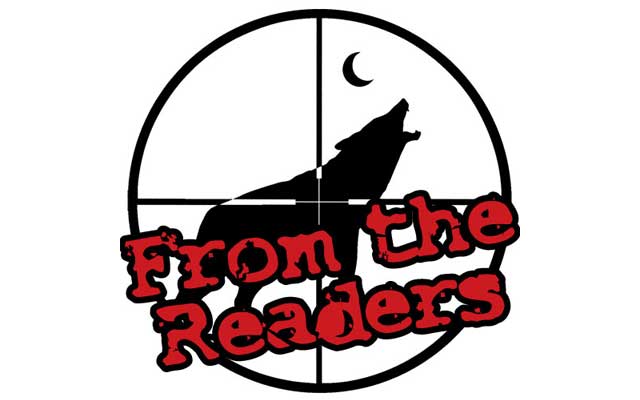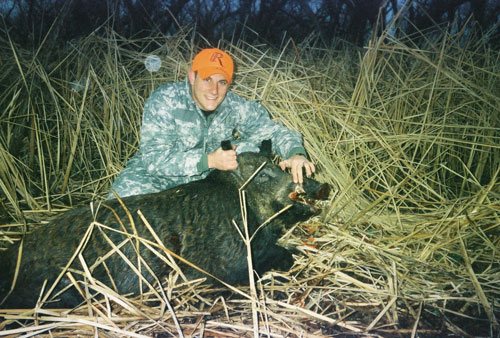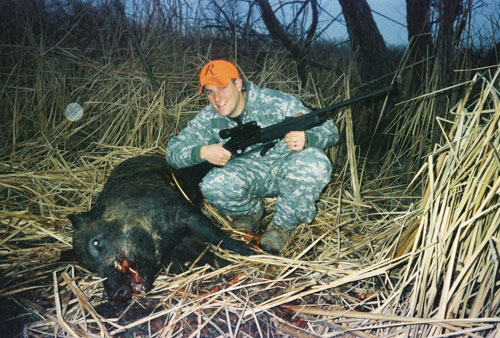 Growing up in the rolling hills of central Virginia, I have often wondered and laughed at the stories of people and the animals they have hunted out West. In particular, I recall the many stories about wild hogs that two Texans, Larry and Robert (also known as “cousin skeeter”), used to tell involving adventurous hunts and tough, aggressive wild hogs. Little did I know that my duty in the U.S. Air Force would send me to Enid, Oklahoma, the farthest west I had ever been.
Growing up in the rolling hills of central Virginia, I have often wondered and laughed at the stories of people and the animals they have hunted out West. In particular, I recall the many stories about wild hogs that two Texans, Larry and Robert (also known as “cousin skeeter”), used to tell involving adventurous hunts and tough, aggressive wild hogs. Little did I know that my duty in the U.S. Air Force would send me to Enid, Oklahoma, the farthest west I had ever been.
After hearing rumors of wild hogs near a certain wildlife management area (WMA) and wanting to rid myself of boredom in the off-duty hours, I decided to pursue them. In early December I got a game plan together after a few scouting trips and purchasing a new Savage .30-06. I sighted it in for 50 yards, given the close quarters of the willows and reeds of the swamp in intended to hunt. I set off on a solitary adventure that Sunday afternoon.
I talked with an old hunter at the local RV camp and he said, “Stay near the river.” I had previously discovered a lot of hog sign between the North Canadian River and a local lake. Unfortunately, it seemed that these hogs enjoyed living in cramped quarters among the ten-foot tall reeds and low bushes growing in the marshy ground. In the reeds were dozens of “pig trails,” laden with tracks that tunneled through thick brush and reeds. Needless to say, they were not hard to track and I was going in after them alone, even though I had never seen one in the wild before.
 I arrived at the spot, parked my truck on the ridge, said a little prayer for safety, and dragged my kayak below to the river. I hopped in my kayak, strapped my rifle on my back, and began to power upstream about a quarter mile as quietly as I could. Although only 20 yards wide and two foot deep, it had a moderate current and was bitter cold. At the take-out point, I hid my kayak in the reeds, loaded my rifle, and headed out along a well-defined hog trail for about a mile closer to the edge of the lake on one side and the Canadian River on the other. My destination was a spot where the trail ended in an open area 50 x 50 yards wide, surrounded on three sides by a wall of reeds. There were several trails going in and out of the reeds and many of them were so heavily traveled that the hogs had dragged the vegetation out with them and trampled it underfoot. Nearby were two wallows that showed frequent use with some huge tracks and droppings. I backed myself up against a willow tree and parked my rear end. The sunlight was warm and the reeds’ fluffy tops swayed in the breeze as I decided to catnap. Like most catnaps in the woods, I was too excited to fully fall asleep and good thing.
I arrived at the spot, parked my truck on the ridge, said a little prayer for safety, and dragged my kayak below to the river. I hopped in my kayak, strapped my rifle on my back, and began to power upstream about a quarter mile as quietly as I could. Although only 20 yards wide and two foot deep, it had a moderate current and was bitter cold. At the take-out point, I hid my kayak in the reeds, loaded my rifle, and headed out along a well-defined hog trail for about a mile closer to the edge of the lake on one side and the Canadian River on the other. My destination was a spot where the trail ended in an open area 50 x 50 yards wide, surrounded on three sides by a wall of reeds. There were several trails going in and out of the reeds and many of them were so heavily traveled that the hogs had dragged the vegetation out with them and trampled it underfoot. Nearby were two wallows that showed frequent use with some huge tracks and droppings. I backed myself up against a willow tree and parked my rear end. The sunlight was warm and the reeds’ fluffy tops swayed in the breeze as I decided to catnap. Like most catnaps in the woods, I was too excited to fully fall asleep and good thing.
Slowly, I became conscious of a sharp twig snap to my right, the kind created by a heavy animal. Listening closer, I heard footsteps and more twigs snapping. Straining to see to the right as far as I could, I caught a glimpse of movement and light brown, tawny fur. Relieved that is was not a human, I spied several paws moving and bushy tails…coyotes! The four coyotes were approximately 40 yards to the right and milling around close to where I had stopped to observe the area. With their noses to the ground, they were following my scent and smelling my boot tracks. Judging that their reddish-fur and small German-Sheppard size was no match for my .30-06, I started to swing my rifle slowly to the right. Given that I’m not left-handed and couldn’t reach my rifle around the tree, I decided to shift my upper body into a better position. Wrong move. My green cotton duck material coat scraped against the rough bark of the willow tree. It was not a loud noise, but audible enough for the leader of the pack to instantly stop and lock eyes with me through the hole in the brush. Simultaneously, the other three spread out and started to circle behind me to catch my wind as the leader stared me down. Afraid that I might lose sight of him in the next few seconds, I quickly rose the barrel. Unable to torque my head and see through the scope, I sighted down the barrel and fired. I watched as the branch 2 inches above the coyote’s head splintered and hit the ground as all four tore off through the brush and the wall of reeds ahead of me, making quite a bit of noise.
Chuckling to myself, I worked the bolt. I had only seen a coyote once in Virginia prior to that, much less been stalked by one (or four). Heck, I’d only been sitting down for a half hour! My excitement was interrupted seconds later by a distant, high-pitched squeal. I’d never heard one like that in the woods anywhere. A minute later, it happened again…and again…and again. Wild hogs! The coyotes must have flushed them towards me. The sounds seemed to be getting closer, and more frequent. It was obvious that the group of hogs was working towards me and I needed to be prepared. Being mauled to death by hogs in the middle of a marsh an hour’s walk and kayak ride up the Canadian River was not ideal, plus I’d never been here after dark. I only had five bullets, and it sounded like there were more than five hogs coming. As I started to see the reed-tops moving 75 yards away, I heard one particularly heavy, low pitched squeal and a loud crash. For me, there was no other option…I put the rifle across my back and shimmied up the willow tree I had been sitting against, eventually straddling a large branch between my legs and resting my back against the rough trunk. I un-slung my rifle, checked the safety, verified I had a round chambered, and waited. I was coming home with a hog for sure, I thought.
 I could now see the tops of the reeds moving (much like the movie “Jurassic Park”) and knew that a hog would step out any second. I made the decision to not let the hogs over-run my position and decided to shoot the first one I saw. A black shape began to emerge, soon the head and neck were visible, then the legs, and finally the whole animal. It stepped into my shooting lane and stopped for a second to let out a hair-bristling deep growl. It was jet black, with stiff hairs several inches long standing straight up on its head going all the way to its back. The hog was maybe 100 pounds, 3 or 4 feet long and about 2½-feet tall. Its head was adorned with large white tusks curled past the upper lip, visible from 50 yards away. The tail was long and hung straight at its back end, with a tuft of hair at the tip. For a moment in time, I was utterly disgusted at the fierce appearance of this creature. In an instant, I made the decision to raise my rifle and fire, I didn’t want this thing or any of its friends to get any closer to my tree! The hog took a few more steps and let out another bellow as it stepped over the log in my firing lane. Instinctively, I raised my rifle, rested the crosshairs directly behind the shoulder, and fired. The 180-grain soft point slammed into the hog as it let out a blood curdling high pitched squeal, did a head-stand on its two front legs and ran forward and to the right into the reeds.
I could now see the tops of the reeds moving (much like the movie “Jurassic Park”) and knew that a hog would step out any second. I made the decision to not let the hogs over-run my position and decided to shoot the first one I saw. A black shape began to emerge, soon the head and neck were visible, then the legs, and finally the whole animal. It stepped into my shooting lane and stopped for a second to let out a hair-bristling deep growl. It was jet black, with stiff hairs several inches long standing straight up on its head going all the way to its back. The hog was maybe 100 pounds, 3 or 4 feet long and about 2½-feet tall. Its head was adorned with large white tusks curled past the upper lip, visible from 50 yards away. The tail was long and hung straight at its back end, with a tuft of hair at the tip. For a moment in time, I was utterly disgusted at the fierce appearance of this creature. In an instant, I made the decision to raise my rifle and fire, I didn’t want this thing or any of its friends to get any closer to my tree! The hog took a few more steps and let out another bellow as it stepped over the log in my firing lane. Instinctively, I raised my rifle, rested the crosshairs directly behind the shoulder, and fired. The 180-grain soft point slammed into the hog as it let out a blood curdling high pitched squeal, did a head-stand on its two front legs and ran forward and to the right into the reeds.
I quickly worked the bolt as the area exploded with noise. Reeds were rustling and thrashing, and the herd of unseen hogs started squealing and barking. I could hear that they were running in circles just beyond visibility in the reeds. Once again, the reed-tops were shaking, but I couldn’t see the hogs. After about five minutes passed without any more hogs coming out, I began to think about recovering my hog. The only problem was that daylight was fading fast, and the whole herd of hogs continued to strut and squeal just out of sight. Eventually, I started thinking about getting back. How would I navigate after dark? Staying the night in an uncomfortable tree or the ground was not an option. What about the hog? There is no doubt I hit him, but it wasn’t an instant kill. To track him, I had to get through the rest of the herd, and by the sounds being emitted from the reeds, I knew there were more hogs than bullets. I was also sure the other hogs were much larger than the one I shot.
I checked my watch and knew I had no more than about five minutes of daylight before it got dark enough to require a flashlight to see. I had to go look for blood now. I put the rifle sling over my back and shimmied down the tree. About four feet from the ground, I pulled my flashlight out and un-slung my rifle, and jumped. My feet hit the ground ready for combat, my rifle at the hip. After a few tense seconds shining my flashlight at the shaking reeds, I decided to take a couple of steps towards them. My adrenaline was pumping and I felt shaky. The unseen hogs sensed my presence and started squealing and growling even more as I forced myself to move closer. It took every ounce of gumption I could summon to get to the place my hog was standing when I pulled the trigger. My heart was pounding and I could feel my senses narrow. I felt my hearing enhance and focus, and I could suddenly see better in the dark.
I stepped to the log where the beast was standing when I fired. Expecting to find a patch of blood, I found nothing. Circling the spot, I shined the light on the ground and the reeds. It was now completely dark. After looking for blood in the area, I stepped into the reeds looking for just a trace of blood or hair. I found nothing. The hogs in the area immediately started squealing again and I could hear a few moving towards me. It was time to leave.
 I immediately took off in the direction I came from. Using my flashlight and turning around every so often to make sure nothing was following me, I trotted next to the river, stumbling over logs and crashing through brush until the squealing of the hogs behind me was replaced by the howling of coyotes close and far away. I ran for about a mile until I was sure that I had gone past my kayak. Just then, I tripped right over it. Putting my rifle on my back again, I dragged my kayak out of the brush and jumped in. I paddled across the frigid river as fast as I could. For the first time in three hours, I felt safe.
I immediately took off in the direction I came from. Using my flashlight and turning around every so often to make sure nothing was following me, I trotted next to the river, stumbling over logs and crashing through brush until the squealing of the hogs behind me was replaced by the howling of coyotes close and far away. I ran for about a mile until I was sure that I had gone past my kayak. Just then, I tripped right over it. Putting my rifle on my back again, I dragged my kayak out of the brush and jumped in. I paddled across the frigid river as fast as I could. For the first time in three hours, I felt safe.
As I loaded my kayak into the truck, I took a moment to thank the Lord for keeping me safe. On the way driving home, I was smiling ear-to ear. What a wild evening in Oklahoma! Coyotes, wild hogs, climbing trees and kayaking across a river, I couldn’t make this up. It is a story I will carry with me for as long as I can remember. Unfortunately, I never found my hog. However, in two months time, I had perfected the art of pursuing wild hogs. Instead of the scoped .30-06, I used an old 12-gauge pump with open rifle sights and rifled slugs, making head shots whenever possible. I also learned that hogs have most of their vitals hidden between their shoulders, so a typical deer-hunters’ shot just behind the shoulder will cause a tough hog to run hundreds of yards before expiring. This is exactly what happened to the hog I shot in the aforementioned story. Later that year, a buddy of mine, Craig Henry (the one in the picture), found the boar’s skeleton, pulled its long upper tusk and gave it to me as a gift for taking him on a hunt in my spot where we killed a 300-pound monster. Hopefully, one day I will be able to come back to this wild place in Oklahoma.
Want to see your article in Predator Xtreme? Send us your predator hunting story or hunting tip (350 words) and one to two high-resolution digital images to molis@grandviewmedia.com.






